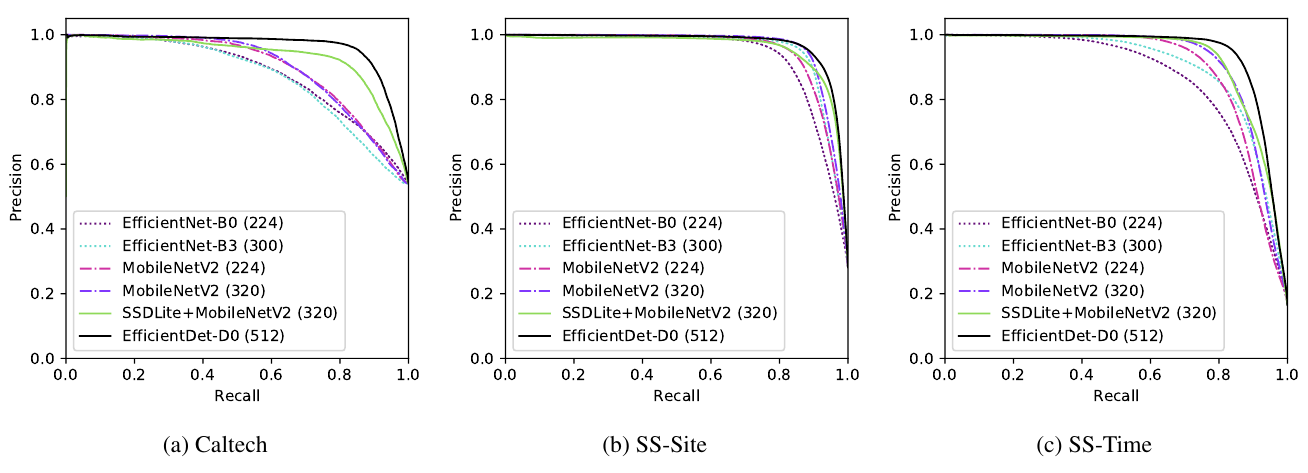This is the origin TensorFlow implementation for Filtering Empty Camera Trap Images in Embedded Systems
Prepare an environment with python=3.8, tensorflow=2.3.1, and install the TensorFlow Object Detection API.
Dependencies can be installed using the following command:
pip install -r requirements.txtCaltech and Snapshot Serengeti Datasets can be downloaded from Lila.
We used the recommended Lila train/val partitions for splits based on locations (site). The hyperparameters were tuned using a val_dev partition which was split from the train split of each data set.
For Caltech, we only used a subset of images containing bounding boxes plus a similar amount of instances sampled from images labeled as empty.
For Snapshot Serengeti, we also split the dataset regarding time (seasons). The list of images used for each partition can be found here.
We also provide scripts for resizing images and convert dataset to tfrecords format. See dataset_tools folder.
To train a classifier use the script main.py:
python main.py --training_files=PATH_TO_BE_CONFIGURED/caltech_train.record-?????-of-00068 \
--num_training_instances=40606 \
--validation_files=PATH_TO_BE_CONFIGURED/caltech_val_dev.record-?????-of-00012 \
--num_validation_instances=6701 \
--num_classes=2 \
--model_name=mobilenetv2 \
--input_size=224 \
--input_scale_mode=tf_mode \
--batch_size=128 \
--lr=0.01 \
--epochs=10 \
--randaug_num_layers=2 \
--randaug_magnitude=2 \
--model_dir=PATH_TO_BE_CONFIGURED \
--random_seed=42The parameters can also be passed using a config file:
python main.py --flagfile=configs/efficientnet_b0_224x224_caltech_agnostic.config \
--model_dir=PATH_TO_BE_CONFIGUREDFor more parameter information, please refer to main.py. See configs folder for some training configs examples.
To train a detector use the following script object_detection/model_main_tf2.py from TensorFlow Object Detection API:
# From the tensorflow/models/research/ directory
python object_detection/model_main_tf2.py \
--pipeline_config_path=PATH_TO_BE_CONFIGURED/ssd_efficientdet_d0_512x512_serengeti_agnostic.config \
--model_dir=PATH_TO_BE_CONFIGURED/efficientdet_d0_serengeti_site_agnostic_12jan \
--alsologtostderrSee configs folder for detectors training config files.
To evaluate a classifier use the script eval_classifier_from_ckpt.py:
python eval_classifier_from_ckpt.py --model_name=mobilenetv2 \
--input_size=320 \
--num_classes=2 \
--input_scale_mode=tf_mode \
--ckpt_dir=PATH_TO_BE_CONFIGURED/mobilenet_v2_320_caltech_agnostic_19nov \
--validation_files=PATH_TO_BE_CONFIGURED/caltech_val_small.record-?????-of-00009To evaluate a detector as a classifier use the script eval_detector_from_saved_model.py:
python eval_detector_from_saved_model.py \
--exported_model_path=PATH_TO_BE_CONFIGURED/ssdlite_mobilenetv2_320_caltech_agnostic_19nov_exported \
--model_name=ssdlite-mobilenetv2 \
--num_classes=2 \
--input_scale_mode=uint8 \
--validation_files=PATH_TO_BE_CONFIGURED/caltech_val_small.record-?????-of-00009For more evaluation options, refer to files starting with eval_.
To measure latency on Raspberry Pi, download the TensorFlow Lite benchmark tool for ARM, upload this tool and the TFLite model to Raspberry Pi, and run the command:
./linux_arm_benchmark_model --num_runs=50 --graph=model.tfliteAll model checkpoints and TFLite binary files are available here.
| Model name | Input size | Training set | Precision | TNR | Threshold |
|---|---|---|---|---|---|
| Efficientnet-B0 | 224x224 | Caltech | 60.26% | 25.50% | 0.355 |
| Efficientnet-B3 | 300x300 | Caltech | 56.42% | 12.75% | 0.305 |
| MobileNetV2-224 | 224x224 | Caltech | 58.60% | 20.18% | 0.228 |
| MobileNetV2-320 | 320x320 | Caltech | 58.58% | 20.13% | 0.239 |
| SSDLite+MobileNetV2 | 320x320 | Caltech | 67.03% | 44.42% | 0.166 |
| Efficientdet-D0 | 512x512 | Caltech | 73.31% | 58.86% | 0.148 |
| Efficientnet-B0 | 224x224 | SS-Site-Small | 50.32% | 63.00% | 0.153 |
| Efficientnet-B3 | 300x300 | SS-Site-Small | 57.21% | 71.97% | 0.155 |
| MobileNetV2-224 | 224x224 | SS-Site-Small | 57.72% | 72.55% | 0.188 |
| MobileNetV2-320 | 320x320 | SS-Site-Small | 62.84% | 77.84% | 0.191 |
| SSDLite+MobileNetV2 | 320x320 | SS-Site-Small | 75.32% | 87.72% | 0.167 |
| Efficientdet-D0 | 512x512 | SS-Site-Small | 79.14% | 90.12% | 0.150 |
| Efficientnet-B0 | 224x224 | SS-Site | 73.92% | 86.78% | 0.291 |
| Efficientnet-B3 | 300x300 | SS-Site | 87.67% | 94.73% | 0.438 |
| MobileNetV2-224 | 224x224 | SS-Site | 75.18% | 87.63% | 0.364 |
| MobileNetV2-320 | 320x320 | SS-Site | 82.89% | 92.26% | 0.420 |
| Efficientnet-B0 | 224x224 | SS-Time-Small | 33.08% | 61.90% | 0.159 |
| Efficientnet-B3 | 300x300 | SS-Time-Small | 39.27% | 70.87% | 0.170 |
| MobileNetV2-224 | 224x224 | SS-Time-Small | 30.51% | 57.11% | 0.126 |
| MobileNetV2-320 | 320x320 | SS-Time-Small | 35.74% | 66.13% | 0.147 |
| SSDLite+MobileNetV2 | 320x320 | SS-Time-Small | 47.14% | 78.89% | 0.147 |
| Efficientdet-D0 | 512x512 | SS-Time-Small | 47.35% | 79.06% | 0.143 |
| Efficientnet-B0 | 224x224 | SS-Time | 48.81% | 80.25% | 0.266 |
| Efficientnet-B3 | 300x300 | SS-Time | 64.28% | 89.54% | 0.403 |
| MobileNetV2-224 | 224x224 | SS-Time | 49.12% | 80.50% | 0.317 |
| MobileNetV2-320 | 320x320 | SS-Time | 58.61% | 86.70% | 0.372 |
| Model name | Input size | Latency Float |
Latency Int8 |
|---|---|---|---|
| Efficientnet-B0 | 224x224 | 800ms | - |
| Efficientnet-B3 | 300x300 | 3173ms | - |
| MobileNetV2-224 | 224x224 | 322ms | 237ms |
| MobileNetV2-0.50-320 | 320x320 | 259ms | 237ms |
| MobileNetV2-0.75-320 | 320x320 | 484ms | 408ms |
| MobileNetV2-320 | 320x320 | 635ms | 485ms |
| SSDLite+MobileNetV2 | 320x320 | 840ms | 575ms |
| Efficientdet-D0 | 512x512 | 4631ms | - |
*The entries show average latency over 50 runs. Results are from models trained on SS-Site, but the latency is similar for the other datasets.
If you find this code useful in your research, please consider citing:
@InProceedings{Cunha_2021_CVPR,
author = {Cunha, Fagner and dos Santos, Eulanda M. and Barreto, Raimundo and Colonna, Juan G.},
title = {Filtering Empty Camera Trap Images in Embedded Systems},
booktitle = {Proceedings of the IEEE/CVF Conference on Computer Vision and Pattern Recognition (CVPR) Workshops},
month = {June},
year = {2021},
pages = {2438-2446}
}
If you have any questions, feel free to contact Fagner Cunha (e-mail: fagner.cunha@icomp.ufam.edu.br) or Github issues.
